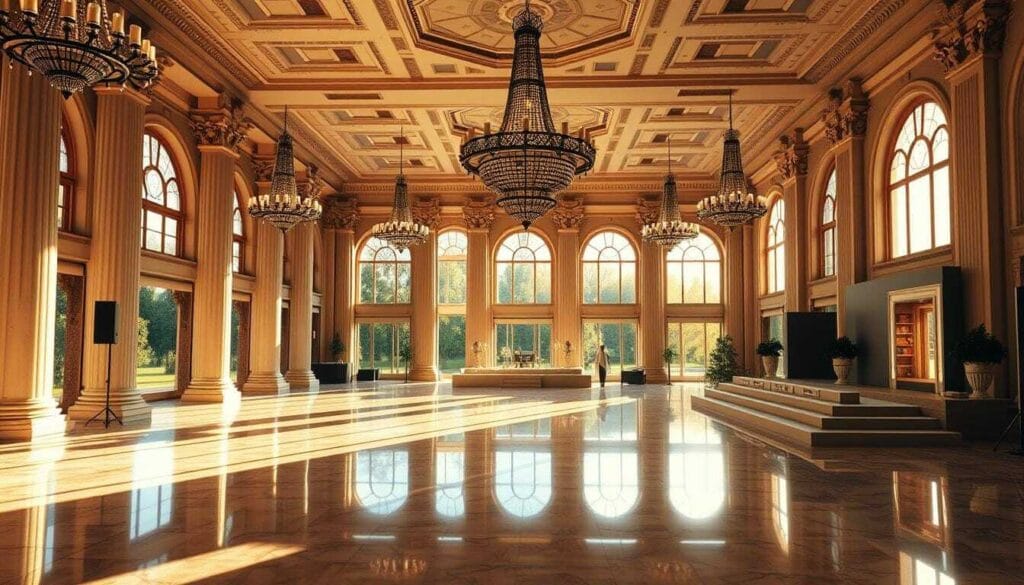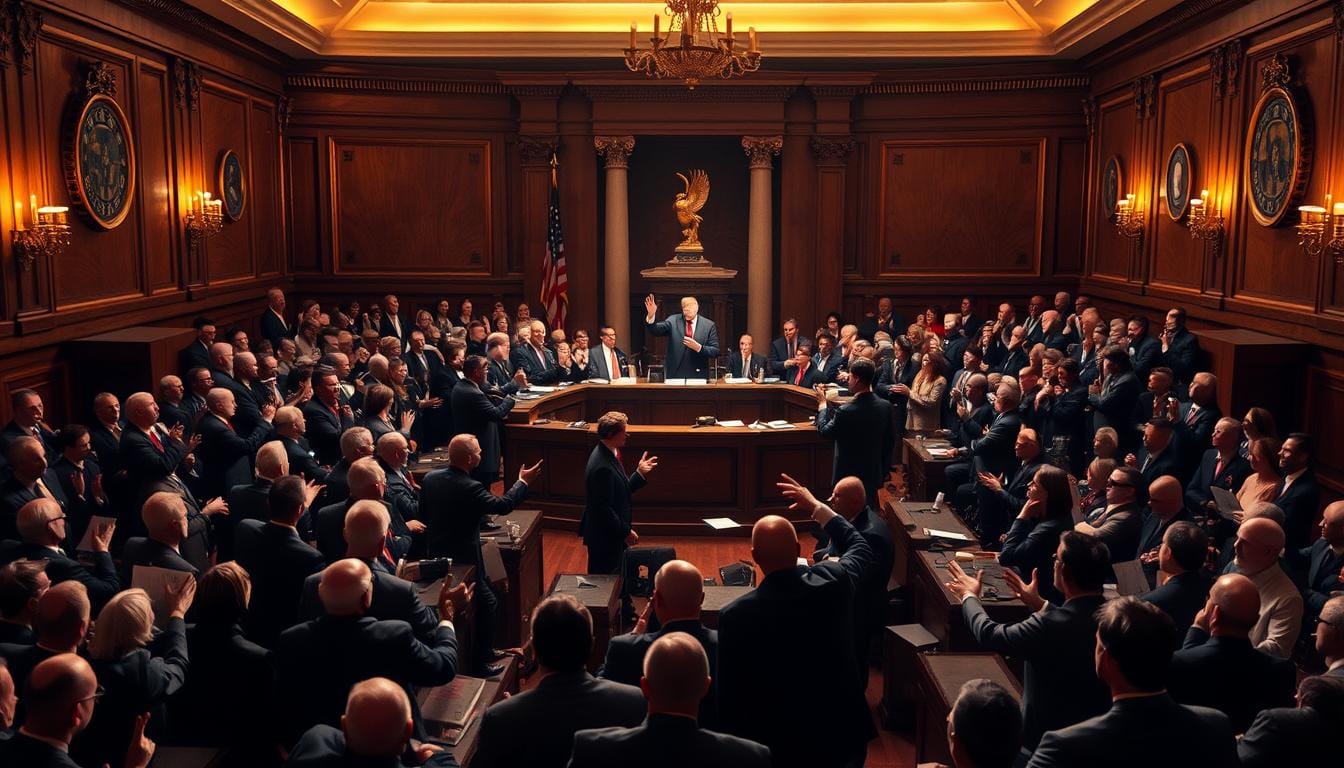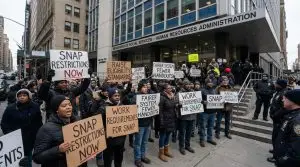Historic Concerns Surround Trump’s New East Wing Ballroom
Uncover the story behind the controversy as the East Wing Ballroom, a historic luxury venue, faces new challenges.

Historic Concerns Surround Trump's New East Wing Ballroom
Click to summarize this article.
East Wing Ballroom: Work on the new East Wing Ballroom is moving quickly, raising historic concerns in Washington. President Donald Trump has chosen a bigger plan after seeing two models. This change will increase the cost of the White House renovation to $300 million, creating a grand event space.
Demolition of the old East Wing has started. Excavators have cleared out offices once used by the first lady and others. Trump believes tearing it down is necessary for a proper renovation.
Renderings show a new luxury venue that will stretch from the East Colonnade. The renovation team, led by James McCrery, has been working hard over the summer. They plan to submit their plans to the National Capital Planning Commission soon.
Historic preservation groups are worried about the changes. They point out that the last major change to the White House was in 1942. A statement from historians and architects has added to these concerns. For more information, please see the statement regarding the proposed ballroom addition.
East Wing Ballroom Key Takeaways
- The East Wing Ballroom has expanded in size and price, now projected to cost $300 million.
- Demolition of the East Wing is in progress, with offices cleared and staff relocated.
- Renderings show a luxury venue extending from the East Colonnade on the former site.
- Weekly planning includes the White House team, the Secret Service, and McCrery Architects.
- NCPC review is expected, but disputes over demolition authority drive historic concerns.
- Preservation voices highlight the 1942 benchmark and the stakes for White House renovation.
Preservation Outcry and Historical Context for the East Wing
The debate over the 1942 East Wing has moved from policy circles to the front lawn. As demolition advances, advocates for historic preservation warn that a rushed timeline risks erasing a key chapter in White House life and protocol, stoking a broad public outcry.
Why preservationists object to demolishing the 1942-era East Wing
The East Wing, rebuilt in 1942, anchors the visitor journey with a wood-paneled foyer and a route that frames state hospitality. Preservationists argue that removing it before full public review undermines the checks that safeguard iconic federal sites and their classical balance.
They note that renderings for a stylish event space and an exclusive wedding venue do not replace the need to assess scale, materials, and sightlines. The concern is not only what goes in, but also how any addition meets the character of the White House.
Calls to halt leveling from leading historic organizations
The National Trust for Historic Preservation and the DC Preservation League have urged a pause so agencies and the public can weigh the impacts. Rebecca Miller of the DC Preservation League criticized moving ahead without the customary submissions to the National Capital Planning Commission and the U.S. Commission of Fine Arts.
Former NCPC chair L. Preston Bryant Jr. has said that demolition is typically reviewed as part of a single project path, a view echoed across the field of historic preservation. That stance has gained traction as scrutiny increases.
Images of demolition and public shock amid a multi-year project
Footage showing excavators tearing into the facade triggered a surge of public outcry. With portions already reduced to debris, questions have mounted about the process and transparency as the site readies for a new ballroom, as described in recent reporting.
Observers fear that the massing of new construction could overwhelm the residence. The visuals have sharpened the stakes, placing the 1942 East Wing in the center of a national debate.
The East Wing’s role as a primary entry for tours and social events
For generations, the East Wing has been the primary entrance for public tours and social events, shaping the first impressions of the Executive Mansion. Its choreography of arrival supports protocol, security, and host duties that define high-level gatherings.
Replacing that gateway with a stylish event space may alter movement, ceremony, and symbolism. Even supporters of an exclusive wedding venue concede that any shift must respect how the 1942 East Wing knits together history, access, and dignity.
| Feature | 1942 East Wing | Proposed Ballroom | Preservation Concern |
|---|---|---|---|
| Primary Function | Main entry for tours and social events | Large-capacity, stylish event space | Loss of ceremonial gateway |
| Historical Significance | Integral to mid-20th-century White House evolution | New construction with a contemporary program | Continuity of historic preservation values |
| Public Process | Traditionally subject to federal review | Proceeding amid calls for more review | Transparency and agency oversight |
| Symbolism | Protocol-focused, visitor-centered | Exclusive wedding venue | Balance between access and prestige |
| Visual Impact | Scaled to the residence’s classical composition | Larger footprint with event emphasis | Risk of overwhelming historic massing |
East Wing Ballroom
The East Wing Ballroom is a grand space designed for significant events. It’s bigger than I first thought, perfect for ceremonies, concerts, and dinners. It’s a place where tradition meets modern needs.
Scale and scope: larger-than-planned grand ballroom and elegant event space
Two mockups evolved into a larger design, featuring ample space and clear views. Weekly meetings with top staff and security helped shape it. Now, the East Wing Ballroom is ready for large events, replacing the old East Wing.
East Wing Ballroom Projected cost rising from $200M to $300M and what it signals
The cost increased to $300 million, indicating the project is complex. It has high-quality materials and lighting for events. This change makes it ready for quick changes between events.
Details on the demolition and updates are ongoing. You can find more in this White House ballroom update.
Design cues: Louis XIV-style interior echoing Mar-a-Lago’s luxury venue aesthetic
The design features gold, mirrors, and crystals in a Louis XIV style. The luxury of Mar-a-Lago inspires it. This creates a space where elegance meets function, perfect for events.
Positioning on the grounds and renderings showing a premier banquet hall
The ballroom is located along the East Colonnade, above the old East Wing. It allows for easy movement and keeps service areas hidden. This makes it a top choice for events.
| Feature | Planned Approach | Event Impact | Operational Note |
|---|---|---|---|
| Scale | Larger-footprint grand ballroom | Accommodates concerts and state dinners | Supports wider aisles and VIP buffers |
| Design | Louis XIV-inspired finishes | Elevates elegant event space optics | Integrates cameras with minimal intrusion |
| Cost | $300M projection | Premium materials and lighting grid | Signals long-term, showcase intent |
| Placement | Former East Wing footprint | Direct link to South Grounds | Streamlines arrivals and service lanes |
| Program | Premier banquet hall with flexible staging | Transitions from ceremonies to receptions | Back-of-house kept off main sightlines |
Legal, Regulatory, and Political Oversight Dynamics
The plan for the east wing ballroom has raised significant questions about regulatory oversight and the allocation of legal authority from the outset. Agencies and supporters are debating whether demolition can proceed before approvals are granted. They worry this might hide important details.
Bypassing concerns and separating demolition from approval processes
The White House states that the National Capital Planning Commission intervenes when “vertical” work commences. However, preservation groups believe that demolition should be reviewed from the outset. They want to maintain strong regulatory oversight.
Rebecca Miller of the DC Preservation League says moving ahead without a formal submission is a problem. It denies the public and the Commission of Fine Arts a say in design and mitigation. This debate is similar to concerns raised about the East Wing ballroom plan.
NCPC’s role, timing, and questions about jurisdiction
The National Capital Planning Commission was set up by Congress in 1924. It reviews major federal projects in the area. Its process can take years, as seen with the perimeter fence and a previous pavilion.
Former chair L. Preston Bryant Jr. says he doesn’t recall demolition being split from a submission before. With offices closed, timing became uncertain, raising further questions about jurisdiction.
Commission leadership changes and implications for review
President Trump named Will Scharf as NCPC chair, along with James Blair and another aide as commissioners. Scharf said NCPC would engage after demolition, showing a new approach under new leadership.
This change puts the Commission of Fine Arts and the National Capital Planning Commission on the same path. They will review the construction of the East Wing Ballroom together.
How the National Historic Preservation Act and Shipstead-Luce Act apply
President Lyndon B. Johnson signed the National Historic Preservation Act of 1966. It focuses on public participation and on the agency’s coordination. However, it does not directly apply to the White House, as it shapes regulatory oversight practices.
The Shipstead-Luce Act requires changes to be shown to the Commission of Fine Arts for buildings facing the White House. However, its language is unclear regarding the Executive Mansion, leading to debates about the legal authority for this project.
| Issue | Stated Position | Practical Effect | Key Bodies |
|---|---|---|---|
| Demolition vs. approval sequence | Demolition proceeds before formal review | Front-loads site work, defers design scrutiny | National Capital Planning Commission, Commission of Fine Arts |
| Jurisdiction scope | NCPC oversight begins at vertical construction | Pre-construction phases face fewer checkpoints | National Capital Planning Commission |
| Leadership changes | New NCPC chair and commissioners | Alters timing and sequence expectations | National Capital Planning Commission |
| NHPA coverage | White House is excluded from the statute | Standards guide practice but do not bind | Agencies referencing NHPA processes |
| Shipstead-Luce application | Focus on buildings facing the White House | Creates ambiguity for the east wing ballroom | Commission of Fine Arts |
East Wing Ballroom Conclusion
The East Wing Ballroom is at the heart of a considerable debate. It involves the White House’s history, construction, and the process by which decisions are made. The fast demolition and slow public review have raised many questions.
Images of the demolition have sparked concerns about transparency. A new, grand project is underway. It will change a place that once hosted tours and events.
Trump’s team wants to build a $300 million luxury venue. It will be inspired by Mar-a-Lago and have a Louis XIV style. They see it as a top banquet hall.
But the order of demolition before review is a big issue. Preservation groups consider the 1942 East Wing to be a significant structure. They want a transparent, open process before any significant changes.
Now, the rules and laws are being closely looked at. The NCPC, led by Will Scharf, faces tough decisions. They must consider the National Historic Preservation Act and the Shipstead-Luce Act.
The National Trust for Historic Preservation is also speaking out. They think the new building might be too big and tall. They want a pause until the public review is done, as stated in their statement on the proposed White House.
The future of the East Wing Ballroom is uncertain. If it goes ahead, it will mark a new chapter in White House history. It will test the balance between luxury and preserving a historic landmark.
Public scrutiny and a thorough review are key. They will decide if the new venue will enhance or change the White House forever.










